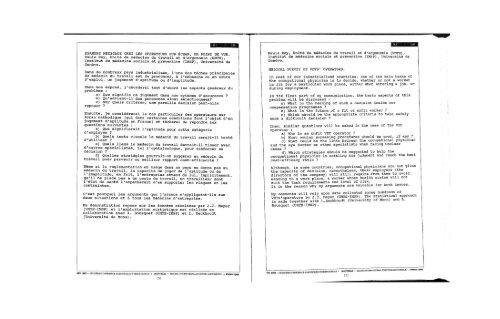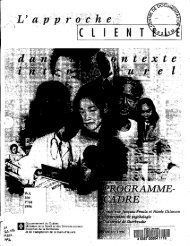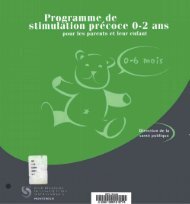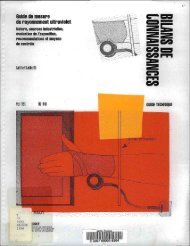le travail à l'écran de visualisation work with display units
le travail à l'écran de visualisation work with display units
le travail à l'écran de visualisation work with display units
You also want an ePaper? Increase the reach of your titles
YUMPU automatically turns print PDFs into web optimized ePapers that Google loves.
Kl 13EXAMENS MÉDICAUX CHEZ LES OPÉRATEURS SUR ÉCRAN, UN POINT DE VUE.Pau<strong>le</strong> Rey, Unité <strong>de</strong> mé<strong>de</strong>cine du <strong>travail</strong> et d'ergonomie (UMTE),Institut <strong>de</strong> mé<strong>de</strong>cine socia<strong>le</strong> et préventive (IMSP), Université <strong>de</strong>Genève.Dans <strong>de</strong> nombreux pays industrialisés, l'une <strong>de</strong>s tâches principa<strong>le</strong>sdu mé<strong>de</strong>cin du <strong>travail</strong> est <strong>de</strong> prononcer, <strong>à</strong> l'embauche ou en coursd'emploi, un jugement d'aptitu<strong>de</strong> ou d'inaptitu<strong>de</strong>.Dans mon exposé, j'abor<strong>de</strong>rai tout d'abord <strong>le</strong>s aspects généraux duproblème :a) Que signifie ce jugement dans nos sytèmes d'assurance ?b) Qu'advient-il <strong>de</strong>s personnes ainsi sé<strong>le</strong>ctionnées?c) Sur quels critères, une pareil<strong>le</strong> décision peut-el<strong>le</strong>reposer ?Ensuite, je considérerai <strong>le</strong> cas particulier <strong>de</strong>s opérateurs surécran cathodique (qui dans certaines conditions font l'objet d'unjugement d'aptitu<strong>de</strong> en France) et tâcherai <strong>de</strong> répondre auxquestions suivantes :a) Que signifierait l'aptitu<strong>de</strong> pour cette catégoried'employés ?b) Quels tests visuels <strong>le</strong> mé<strong>de</strong>cin du <strong>travail</strong> serait-il tentéd'utiliser ?c) Quels liens <strong>le</strong> mé<strong>de</strong>cin du <strong>travail</strong> <strong>de</strong>vrait-il tisser avecd'autres spécialistes, tel l'ophtalmologue, pour renforcer sadécision ?d) Quel<strong>le</strong>s stratégies pourrait-on suggérer au mé<strong>de</strong>cin du<strong>travail</strong> pour parvenir au meil<strong>le</strong>ur rapport coût-efficacité ?Même si la rég<strong>le</strong>mentation en usage dans un pays ne donne pas aumé<strong>de</strong>cin du <strong>travail</strong>, la capacité <strong>de</strong> juger <strong>de</strong> l'aptitu<strong>de</strong> ou <strong>de</strong>l'inaptitu<strong>de</strong>, en fait, l'entreprise attend <strong>de</strong> lui, implicitement,qu|il ne place pas <strong>à</strong> un poste <strong>de</strong> <strong>travail</strong>, un <strong>travail</strong><strong>le</strong>ur dontl'état <strong>de</strong> santé l'empêcherait d'en supporter <strong>le</strong>s risques et <strong>le</strong>scontraintes.C'est pourquoi <strong>le</strong>s arguments que j'avance s'appliquent-ils aux<strong>de</strong>ux situations et <strong>à</strong> tous <strong>le</strong>s mé<strong>de</strong>cins d'entreprise.Ma démonstration repose sur <strong>le</strong>s données récoltées par J.J. Meyer(UMTE-IMSP) et l'exploitation statistique est réalisée encollaboration avec A. Bousquet (UMTE-IMSP) et L. Eeckhoudt(Université <strong>de</strong> Mons).Pau<strong>le</strong> Rey, Unité <strong>de</strong> mé<strong>de</strong>cine du <strong>travail</strong> et d'ergonomie (UMTE),Institut <strong>de</strong> mé<strong>de</strong>cine socia<strong>le</strong> et préventive (IMSP), Université <strong>de</strong>Genève.MEDICAL SURVEY OF VDTS'OPERATORS.In most of our industrialized countries, one of the main tasks ofthe occupational physician is to <strong>de</strong>ci<strong>de</strong>, whether or not a <strong>work</strong>eris fit for a particular <strong>work</strong> place, either when entering a job, orduring employment.In the first part of my communication, the basic aspects of thisprob<strong>le</strong>m will be discussed :a) What is the meaning of such a <strong>de</strong>cision insi<strong>de</strong> ourcompensation programmes ?b) What is the future of a fit or unfit <strong>work</strong>er ?c) Which should be the appropriate criteria to take safelysuch a difficult <strong>de</strong>cision ?Then, similar questions will be asked in the case of the VDToperator :a) Who is an unfit VDT operator ?b) What ocular screening procedures should be used, if any ?c) What could be the links between the occupational physicianand the eye doctor or other specialists when facing unc<strong>le</strong>arcases ?d) Which strategies should be suggested to help theoccupational physician in settling his judgment and reach the bestcost-efficacy ratio ?Although, in some countries, occupational physicians are not giventhe capacity of <strong>de</strong>cision, neverthe<strong>le</strong>ss, their employers (thedirectors of the company) will still require from them to avoidsending to a <strong>work</strong> place, a <strong>work</strong>er whose health status will notsuit the task requirements and <strong>le</strong>vel of risk._It is the reason why my arguments are valuab<strong>le</strong> for both issues.My comments will rely upon data col<strong>le</strong>cted among hundreds ofVDTs'operators by J.J. Meyer (UMTE-IMSP). The statistical approachis ma<strong>de</strong> together <strong>with</strong> L.Eeckhoudt (University of Mons) and A.Bousquet (UMTE-IMSP).TEV 1989 —DEUXIÈME CONFÉRENCE SCIENTIFIQUE INTERNATIONALE • MONTRÉAL « SECOND INTERNATIONAL SCIENTIFIC CONFERENCE — WWDU 1989156—157
















